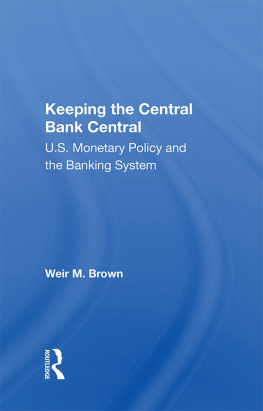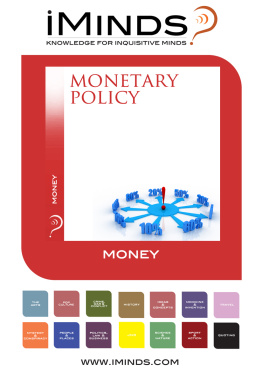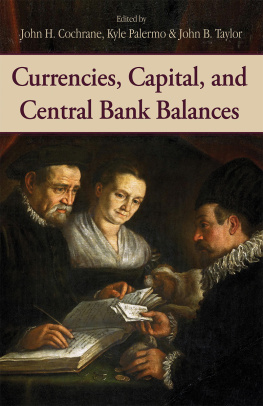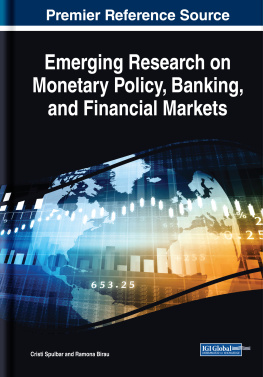First Published 1987 by Westview Press, Inc.
Published 2018 by Routledge
52 Vanderbilt Avenue, New York, NY 10017
2 Park Square, Milton Park, Abingdon, Oxon OX14 4RN
Routledge is an imprint of the Taylor & Francis Group, an informa business
Copyright 1987 Taylor & Francis
All rights reserved. No part of this book may be reprinted or reproduced or utilised in any form or by any electronic, mechanical, or other means, now known or hereafter invented, including photocopying and recording, or in any information storage or retrieval system, without permission in writing from the publishers.
Notice:
Product or corporate names may be trademarks or registered trademarks, and are used only for identification and explanation without intent to infringe.
Library of Congress Cataloging-in-Publication Data
Brown, Weir M. (Weir Messick), 1914
Keeping the central bank central.
"A Westview special study."
Bibliography: p.
Includes index.
1. Board of Governors of the Federal Reserve
System (U.S.) 2. Monetary PolicyUnited States.
I. Title.
HG2563.B67 1987 332.1'12'0973 87-25416
ISBN 13: 978-0-367-01399-8 (hbk)
In the period just before and after the founding of the Federal Reserve System in 1913, bankers, economists, and legislators were intensely absorbed in discussing how to assure a proper functional relationship between the future central bank and the commercial banking system. Of particular concern were the aims of according the central bank flexible means for extending temporary loans to its member banks at times of economic expansion and for serving as lender of last resort in the event of a financial "panic." To help avoid excesses of credit extension or contraction, the Federal Reserve would also need the control instruments necessary to influence regularly the volume and price of money and credit. The provisions incorporated in the Federal Reserve Act and the techniques that evolved in the germinal period 1913-1923 were felicitous and attracted informed attention in other countries, in the view of one eminent scholar, "In the sense of there being avowed recognition of a complex of public [noncommercial] objectives," that period was "indeed the beginning of the self-conscious, discretionary central banking we know today."
During the sixty-odd years that followed, many changes have occurred to affect one side or the other of the Federal Reserve-banking system relationship. Such diverse phenomena as the negotiable certificate of deposit, interest-rate ceilings, the credit card, the automatic teller machine, electronic check clearing, variable reserve ratios, repurchase agreements, and the Eurodollar market have appeared or disappeared. Changes that have significantly affected the interface between commercial banking operations and the Federal Reserve in its responsibility for conducting a coherent monetary policy have usually called for careful study and suitable adaptation of control methods. In most cases these mutations and the mutual adjustments to them have taken place gradually, without great disorder. Not surprisingly, the two notable exceptions to this pattern of orderly adaptation occurred in the wake of severe conjunctural dislocations: the critical deflationary period of the early 1930s and the prolonged inflationary period of the late 1970s-early 1980s, both of whose domestic manifestations were further aggravated by external shocks and imbalance in international payments positions.
Thus in the financial turmoil of the present decade, the subject of banking and the thrift institutions has commanded more public attention than at any time since the Great Depression. Bank failures and liquidity problems have been uncommonly frequent, due partly to an inflation-induced and generalized discrepancy between loan portfolios incurred earlier at fixed interest rates and the rates now being paid on deposit liabilities, and partly to excessive exposure to vulnerable industrial sectors such as petroleum or agriculture. Besides these solvency-related questions, positions have been taken by some banking industry spokespersons regarding the issues of interstate and nationwide banking firms, ownership by commercial corporations, entry of banks into the fields of insurance or security underwriting, and so on. Public discussion has ranged over diverse relationships, many of them adversarial: banks vs. nonbanks; local vs. interstate depository institutions; the securities industry vs. banking.
Much less attention has been devoted, however, to the current state of the relationship between the banking system and the Federal Reserve in regard to the conduct of national monetary policy. It is to this areain the fundamentally important field of macroeconomic policythat this book is addressed. The field is large, and the Federal Reserve Board shares responsibility with other important economic decision-makers for guiding the course of the economy. The book does not undertake to cover the whole subject of macroeconomic policy. What it does seek to examine are two areas that stand squarely at the common border where Fed monetary control meets the banking system. At about the same time that deposit accounts offered at depositories were undergoing marked changes, becoming both more transferable and more interest-bearing, Congressional acts of the early 1980s were lowering or removing reserve requirements from those deposit liabilities of the banking system that were growing most rapidly. Exploration of the implications that these two interfacial changes may have for the conduct of monetary policy constitutes the main object of this book, in the author's hope that it may contribute in modest measure toward maintaining the present effectiveness of the Fed in its crucial position at the center of the U.S. monetary system.
Methods employed in this study are those of fairly simple statistical description and analysis. Given that the object is to examine how the composition and attributes of deposits now compare with those of earlier periods, and similarly to examine the changes over time in the effective levels of required reserves relative to deposits, many of the tables are presented in terms of annual data. Some of these measurements relate to the depository institutions as a group (i.e., including the thrifts), but for reasons of data availability as well as brevity much of the treatment is focused on the commercial banking system. Fortunately, the preponderance of the statistical material needed for analysis was available from published sources. In a few instances in which publication of key Federal Reserve series has been discontinued, the Research and Statistics Division of the Board of Governors kindly provided these data for a few selected dates, which I gratefully acknowledge.
In addition, I was assisted at various stages by conversations with and information supplied by persons at the Board and the several Federal Reserve Banks. I thank them all, and should not fail to mention individually Edward R. Fry, James E. Glassman, Jacqueline A. McDaniel, Mary M. McLaughlin, Ann-Marie Meulendyke, J. Charles Partee, and Daniel L. Rhoads.
The Brookings institution was very considerate in according me special guest privileges during the course of this study, and the library carrel provided me here was an agreeable base for research and scholarly association. The skill of Mareida Grossman and Deniese A. Young in typing the text and designing the tables was of great assistance.













